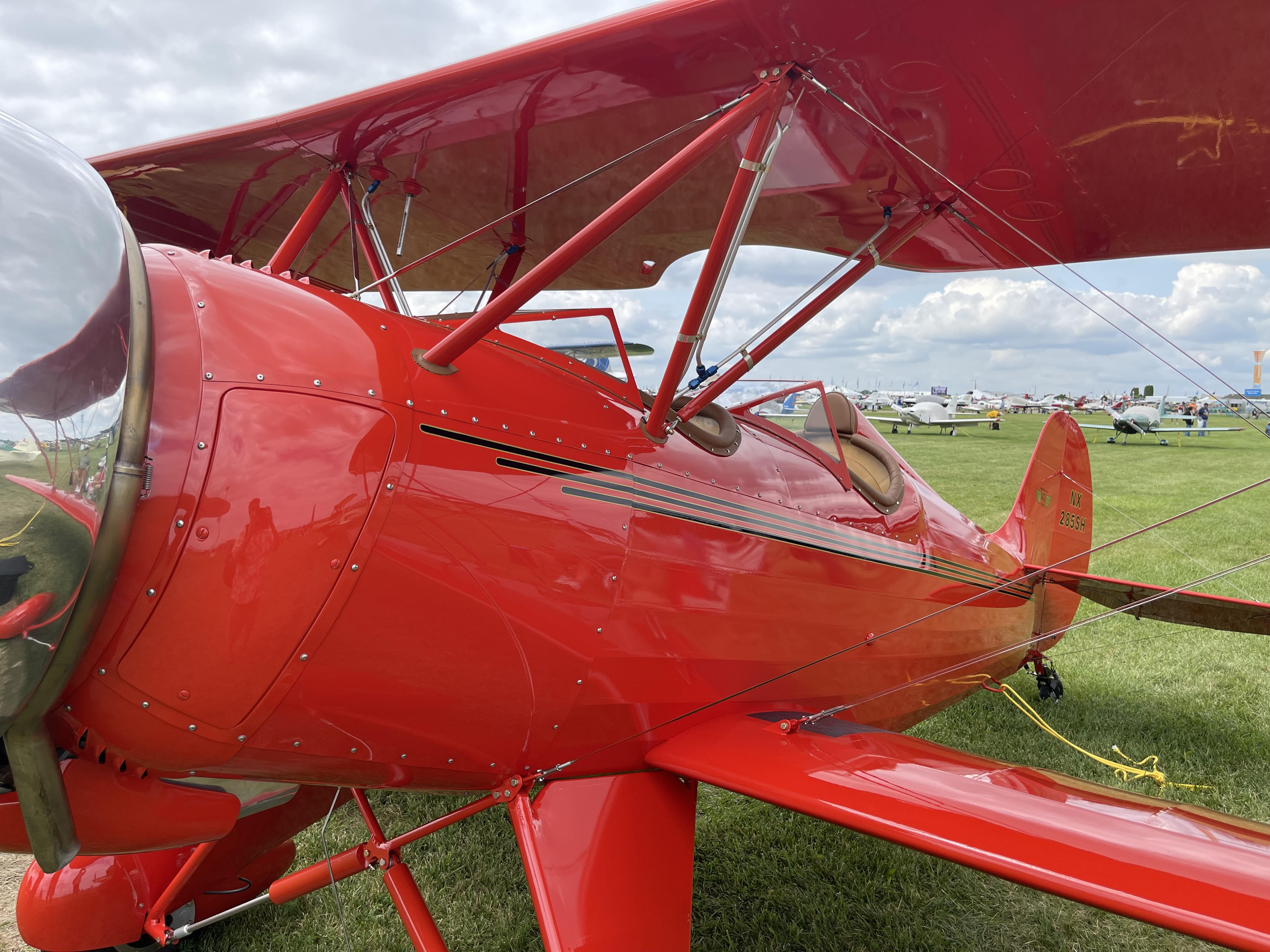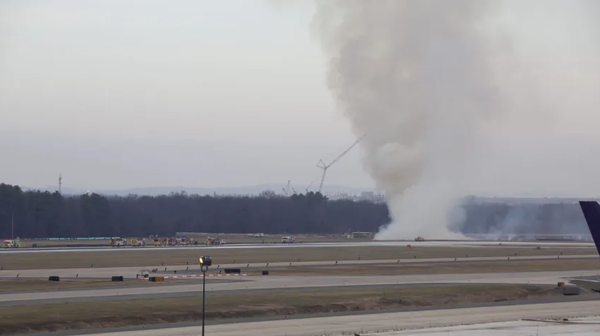At the EAA AirVenture 2024, the hallowed ground at the virtual center of Wittman Field in Oshkosh, Wisconsin, is set aside for rows and rows of aircraft at the heart of the Experimental Aircraft Association: the homebuilt.
And smack-dab in the middle of this premium real estate sits a wonderful gal named Hazel. She poses elegantly, resplendent in the grass, her red paint a beacon to all, a signal that this work of aeronautical art is indeed special.

Hazel is a symbol of the grassroots of all grassroots aviation, not only a homebuilt but a homebuilt from the plans up, a Hatz Classic two-place biplane with a nine-cylinder Verner radial under a gleaming stainless steel cowling brought at a mirror-like reflective shine. No kit, no preformed parts, no quick-build assemblies.
“All of these forms had to be hand-tooled,” one of Hazel’s creators, Kathy Shultz, explained, pointing out the metal surfaces of the lower wing’s ailerons.
Rick Shultz, Kathy’s spouse and Hazel’s co-creator, explained every wing spar and rib was formed by hand from wood. Spruce, to be exact.

Such a project often requires developing one's own tools, jigs, and processes. Such was the case with Hazel, making it a ten-year labor of love for the Shultzs of Ohio. Hazel’s propeller sleeve card lists both Rick and Kathy as the builders.
“We worked on it together,” Rick expounded. “Sometimes I’d say I've had it. She would be the one to tell me, ‘get your rear back in the shop!’”
Kathy smiled and added, “Sometimes I had to remind him it’s about the journey, not the destination.”

Indeed, Rick offered wise counsel for anyone considering building their own plane; counsel heard more than once at Oshkosh: don’t forget you have a family. The building process can be all-consuming. So be sure to have dinner together and go out together.
Hazel has a wingspan of 25 feet and an empty weight of 1,700 lbs. The Verner radial will cruise her along at 85 mph, and Hazel will land at 65 mph. The cockpits, Rick pointed out, are modeled after a Waco. Both cockpits feature simple yet elegant woodwork and leather combings.
The full instrument panel is in the rear cockpit, but nothing fancy. Just the typical six-pack, with a basic turn coordinator with its floating ball, a wet compass, and an airspeed indicator that reads miles per hour instead of knots.

Meeting FAA Requirements
Hazel was finished and first flown in the latter part of 2023. Meeting the FAA requirements for registration and certification of a homebuilt aircraft is fairly rigorous. The airplane must be inspected by an FAA inspector or designated inspector before an airworthiness certificate is issued.
Following a successful inspection, a pilot must perform 25-40 hours of test flights in specific non-populated areas to ensure that all components operate properly. Only then may passengers be flown in the aircraft.

The EAA publishes a flight test manual that guides homebuilders in completing the flight test process, and the Shultzs were able to meet the requirements in roughly 26 hours. “Really, almost just in time to come out this year,” Rick said.
The open cockpit Hazel will most likely stay hangared during the Ohio winters. The Shultz’s also have an Aeronca Champ they can fly to stay warmer in its enclosed cabin.
“I used to say it had to be at least 60 degrees for me to go flying. As the years go by, it’s more like 70 degrees now,” Shultz smiled.

The Shultzs placed a thick photo album on top of a crate at Hazel’s nose for visitors to peruse. Dozens of photographs detailed the long and loving process of her creation. It sat under one of Hazel’s most attention-getting features, the gleaming silver cowl around the engine’s cylinders.
“I took a stab at the sheet metal work on that,” Rick explained when asked about it. “But eventually, I asked a friend who has experience in that kind of work. That’s how you get it done, reaching out. There’s no shame in asking for help.”
Kathy added, “That’s what’s been amazing, all the people we’ve met along the way, who have helped, the lifelong friends we’ve met flying.”
China Eastern Inaugurates New World's Longest Flight » Making a Stopover in Dubai? Discover How to Book a Yacht and Explore the City in a New Way » When Will the Boeing 777X Enter Service? Delays, Certification, and 2027 Outlook »
Comments (4)
 Craig Meshaw
A wonderfully dedicated work of art!
Craig Meshaw
A wonderfully dedicated work of art!
 Frank Barrett
It's coaming," not "combing."
Frank Barrett
It's coaming," not "combing."
 Edward Carr (author)
Good catch!
Edward Carr (author)
Good catch!
 Rick Block
Great story, and absolute dedication from start to finish.
It presents nothing less than stunning, definitely a soft spot for these old girls.
Thanks for sharing.
Rick Block
Great story, and absolute dedication from start to finish.
It presents nothing less than stunning, definitely a soft spot for these old girls.
Thanks for sharing.
Add Your Comment
SHARE
TAGS
STORIES EAAOshkoshOSH24AirVenutreHatzbiplanehomebuiltamateur-builtRECENTLY PUBLISHED
 When Will the Boeing 777X Enter Service? Delays, Certification, and 2027 Outlook
The Boeing 777X was meant to be the crowning achievement of modern wide-body aviation: a folding-wing giant capable of carrying more passengers more efficiently than any twin-engine jet in history. Instead, the program has become a case study in aerospace endurance.
INFORMATIONAL
READ MORE »
When Will the Boeing 777X Enter Service? Delays, Certification, and 2027 Outlook
The Boeing 777X was meant to be the crowning achievement of modern wide-body aviation: a folding-wing giant capable of carrying more passengers more efficiently than any twin-engine jet in history. Instead, the program has become a case study in aerospace endurance.
INFORMATIONAL
READ MORE »
 Engine Failure Forces United 777 Emergency Landing, Starts Brush Fire at Dulles Airport
A United Airlines Boeing 777-200ER bound for Tokyo made a safe emergency landing at Washington Dulles International Airport (IAD) on Saturday afternoon after an engine failure shortly after takeoff ignited a brush fire near the runway. All 275 passengers and 15 crew members aboard United Flight 803 were reported uninjured.
NEWS
READ MORE »
Engine Failure Forces United 777 Emergency Landing, Starts Brush Fire at Dulles Airport
A United Airlines Boeing 777-200ER bound for Tokyo made a safe emergency landing at Washington Dulles International Airport (IAD) on Saturday afternoon after an engine failure shortly after takeoff ignited a brush fire near the runway. All 275 passengers and 15 crew members aboard United Flight 803 were reported uninjured.
NEWS
READ MORE »
 Making a Stopover in Dubai? Discover How to Book a Yacht and Explore the City in a New Way
Planning a stopover in Dubai? Learn how to book a yacht in Dubai and explore the city’s skyline, landmarks, and coastline from a private yacht.
INFORMATIONAL
READ MORE »
Making a Stopover in Dubai? Discover How to Book a Yacht and Explore the City in a New Way
Planning a stopover in Dubai? Learn how to book a yacht in Dubai and explore the city’s skyline, landmarks, and coastline from a private yacht.
INFORMATIONAL
READ MORE »


